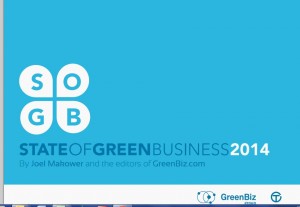Here’s installment #3 of my short summary of “The Big Pivot,” Andrew Winston’s latest book. For the “too busy” green business owner or corporate sustainability person, these posts are a shortcut to help you get the gist of it.
Yesterday we covered the “Vision Pivot”. Today, we look at the second major “pivot”– or change in direction – that companies must make. He calls it the Valuation Pivot.
This pivot, in my view, gets to the crux of the biscuit. The Valuation Pivot is about money and measurement and the very poor job our current businesses do of accurately measuring business value.
A Super-Condensed Summary: The Valuation Pivot
On Sustainability, Companies Need to Put their Money Where their Mouth Is
Winston asks the simple question, “What are people in your company paid to do?” If they are paid to hit the earnings number every 90 days, and not paid for addressing the mega–challenges of a hotter, scarcer world, then the results are predictable.
So pay people to address the mega-challenges. Awards are nice, recognition is good. But money motivates action. Make sustainability part of everyone’s performance review, and change the incentives for senior executives.
When companies pursue sustainability seriously, they reap another benefit: engaged employees. Recent research by Gallup shows that firms with the most engaged employees are:
- 16% more profitable
- 8% more productive
- have 25% – 49% lower turnover
than firms with the least engaged employees.
Many employees find sustainability an engaging issue. It’s not surprising. “It’s inspiring to work on something that’s both profitable and for the larger good,” Winston says.
Companies Need to Redefine Return on Investment (ROI)
Winston is brave to say this.
Why redefine this time-honored method of making investment decisions? Because “ROI is broken,” says Winston. “Most companies use ROI as a blunt tool, without measuring the full spectrum of value.”
“The problem is, there are many contributors to business value that we fail to put a number on.” These include business resilience, risk reduction, increased sales potential, and easier hiring.
Companies pursuing sustainable business practices may adjust their ROI models. Approaches range from dedicating funds for green investments to lowering the hurdle rate to pricing carbon internally. IKEA, for example, lets green projects pay off in 10 to 15 years, instead of the standard 2 years.
Ultimately, it’s a leadership decision as to how to evaluate the return on green investments.
Put a Number on the Value of Natural Capital
Natural capital is “everything the planet provides for our economy and our lives, including forests, fisheries, soil, metals, coastal wetlands,” and so on. The list is very long.
Historically, there has been no price for these “eco-system services.” But in order for markets to work, they need prices. So some companies have begun the task of estimating the value of these things. According to Winston, “the most quoted estimate of the total value that nature provides is $33 trillion annually (actually $48 trillion in today’s dollars.)
It’s early days yet, and no one standard has emerged. But as Winston points out, “We live on a single planet with a finite amount of resources. Either we manage these resources well, or we don’t survive.”
Valuing natural capital accurately, instead of treating resources as “free”, will help businesses make far better decisions.
Tomorrow: The Partner Pivot




